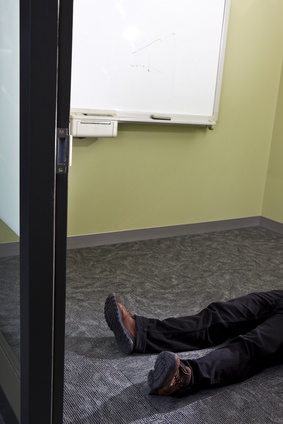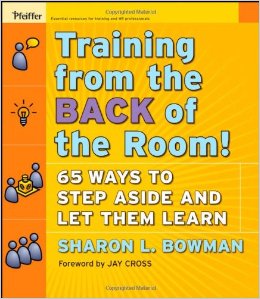I find many things puzzling. One that is puzzling, frustrating, and annoying is how people continue to use outdated methods to train.

We still have so many people who run an entire training session (half-day, 1 day, 2 day, 3 day, whatever) with students sitting in a dark room staring at slides. When I hear “we have a lot of information to teach, so we need 100s of slides a day”, it makes me physically ill. If this sounds like your training, it might just smell. If you are trying to do training that does not smell and are stuck, read on!
In the past, I’ve certainly taught classes with more slides and words on slides than I should have. I wish I had a time machine, but I don’t! My point is that we can all improve over time if we choose to. Maybe your training has some engaging modules, but you want to move away from slides or increase retention. There are options! Many trainers I know have even eliminated all slides from their classes. Saying “death by PowerPoint” always gets some laughs, but slides are not always the root cause. The root cause is that many people don’t know how people learn (or maybe some don’t care — but I know a lot of trainers who care a lot!).
Dumping a pile of information on people via massive amounts of wordy slides and lecture is simply not effective!
What Makes Training Amazing & Engaging
There are so many elements of great training, I’ve included five that I like to focus on.
- Engaging students to tap into what they already know — Students know a lot. Even students who say they have zero knowledge of your

If you’ve packed up for the day and you’re heading out… but find people passed out in the chairs… you might need to increase engagement. topic! There are always ways to connect topics to what people already know. If you train on ‘how to sell’ and you are training people who have never been salespeople, does that mean they know nothing about sales? Of course not, people know plenty. They’ve all been sold to and they’ve actually tried to sell a lot more than they realize (ideas, goals, etc.). Engaging people to connect what they already know to new ideas is a key way to open people’s minds to new ideas.
- Use multi-channel learning modes –You as a trainer need to be using more than just a singular visual and verbal approach (e.g. reading slides). As I said, slides on their own are not bad, they can act as queues for the audience — and using images, quotes, short videos, or other engaging items on the slides can be quite useful. But if you are a one-trick-slide-pony, you need to branch out and stop horsing around! You can use charts, games, posters, building materials (anything people can build with), sound, discussions in varying group sizes, interactive sessions, experiential sessions, and so much more. Each module can be delivered in different ways that support the outcomes for that topic.
- Markers and exercises! — Markers, along with other supplies that allow you and the students to do more than talk and sit there (respectively) is critical!! People need to explore the ideas you are teaching. They need to practice the ideas! This goes along with multi-channel. People need to practice what they are learning using various modes. While having awesome markers, a great room, and a variety of engaging materials is an indicator that you may have an amazing training session, it is not a guarantee. However, when you only have 4 dried-out markers, your chance to visually engage anyone is fairly low! For a marker fanatic (busted) having the right markers to make awesome charts, posters, diagrams, and illustrations is a must.
- Engaged trainers and facilitators — As a trainer, you need to be engaged and you need to know your topics. They go hand-in-hand. Great trainers can read the room. They can engage and see things that are happening that students don’t notice. They can address challenges to keep the course on track towards the outcomes,

If people are simply passing out in your training… you do have a problem. while allowing flexibility for what is emerging in the class. I believe anyone, if they want to and seek out the help they need, can learn to be engaging.
- A trainer who is okay making a mistake — When I’m in a training and the trainer makes a mistake that everyone notices, are they willing to correct themselves publicly? This is not about shaming yourself or even the mistake, it’s about being human. Being able to connect to the people in a class is a very important part of teaching. If students can’t relate to you, how open are they going to be to anything you share?
Ways to Improve Your Training
So how can you improve your training? There are plenty of options!
- Get Visual — There are many books out there on how to use graphics and visuals. If your ability to draw sucks, but do you think it will improve by NOT drawing?
- Check out many of the books on visual meetings or sessions. One to start with, Visual Meetings by David Sibbet.
- Lynne Cazaly has some great ideas around visual meetings. I saw her present a session last year where, among other things, we all created 25 graphics on the fly, which was partially to prove to everyone that they could indeed draw! The video and slides from the session, The Girl with the Chisel Tip Marker, is available if you want to check it out! (the Speed Sketch Game, starts out about 1:07 — to create the graphics)
- Ensure people are engaging in ways that increase retention. Writing notes, instead of typing them on a laptop, can improve what people remember and the depth of what they remember. Take a look at this article, “Attention, Students: Put Your Laptops Away” on the topic.
- Get markers — This might seem overly simple, but it is so EASY to do, why would you NOT do it? If you want to learn more about the specific ones we use and why we use them, take a look at Marker Fanatics & Facilitating with Great Markers!
- Observe trainers, presenters, facilitators, and speakers — Note anyone who does a training session that you liked or even an element that you liked. Write it down and figure out how to use that same approach in your training. Ask them where they learned that technique. There are a lot of people doing some amazing work out there that we can all learn from. On the other side, there are people who are not doing anything new. If you happen to be in one of those training
 sessions, what are they doing that is NOT appealing to you? You can say it sucks, but what would you do differently? How would you deliver that module in a more engaging way?
sessions, what are they doing that is NOT appealing to you? You can say it sucks, but what would you do differently? How would you deliver that module in a more engaging way? - Learn how to create training that is based on brain science! — Buy ‘Training From the BACK of the Room‘ by Sharon Bowman and take a look at Sharon’s website for tips and ideas. The book is based on brain research. We know that the brain is always paying attention to something and is always learning. It might not be learning what YOU are training, but it is learning something! At its foundation is the fact that the brain enjoys stimulation and changes to keep it engaged. If someone is going on and on, it’s a snooze fest for the brain. Might as well feed it a big turkey dinner… zzzzzzzzzzzzzzz… wait what were you talking about? Oh ya, the brain! So we need to change things up in new and different ways. We need to create engaging exercises and be engaging trainers and facilitators. We need to let people teach each other and as Sharon says “step aside and let them learn.” She gets into much more on these concepts in the book! All of these ideas are what dramatically increases the retention of knowledge during training! We all want to attend training designed to help us learn in the most effective ways!
- Attend a training class — There is a Training From the BACK of the Room class where you can learn how to create amazing training sessions. You can visit Sharon Bowman’s website for a list of classes, or contact us about bringing a public class to your area!
Whether you are a trainer, facilitator, speaker, presenter, agile trainer, agile coach, Scrum Master, manager, or leader, learning how to train and facilitate in ways that increase knowledge retention and engagement of the people in the room will always increase your success!











Hey Jake! Great blog post – very humorous while also being practical and informative 🙂 Cheers to Agile for All 🙂 Sharon
Sharon, thanks! I try to add a bit of amusement into these!